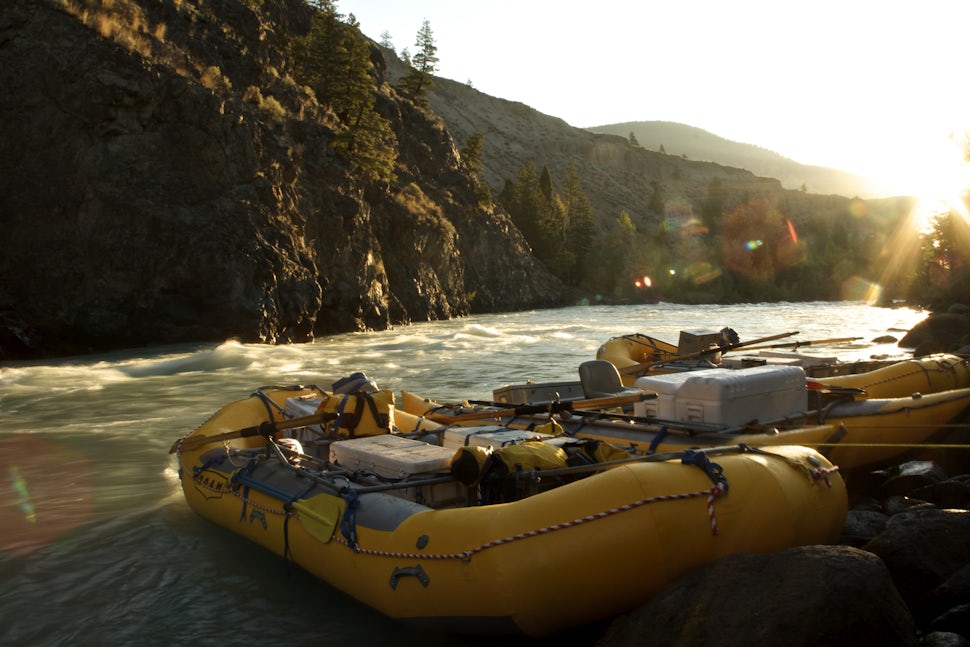Rafting The Chilko: An Expedition Leader's Story (II)


Tom Wells is a professional whitewater rafting guide. Here, he shares a story of a recent rafting trip on the Chilko River in British Columbia (this is part two of three; click here to read part one).
"Swimmer!" called one of the six paddlers now with me. The mysterious yellow object was a drybag, containing someone’s three-day personal kit. I let it go, watched for swimmers. Down came another drybag, and another. The river was going to work on the unseen raft, ripping buckle from strap, strap from frame. The people looked on as their belongings floated by in giant "waterproof" crisp-packets. No more swimmers. I checked on the couple who’d just been rescued. Glassy-eyed and wobbly as wet-furred foals, but uninjured and warm with adrenaline. I unstrapped the "wrap kit", a rat-eaten duffel bag laden with heavy rope for raft extraction…
One of the guests had been on a military peacekeeping deployment, during which she had applied the butt of her rifle to the groin of a jealous man, who was in turn holding a gun to a doctor, who was in turn about to deliver the jealous man’s child with all the "liberties" a doctor must take in the circumstances. The peacekeeper had been charged with excessive force. "You’re in charge," I said to her. "Don’t let anyone leave." I asked another to follow me, and bushwhacked upstream toward the stricken raft.
Through the steep forest we scrambled, branches snatching at our eyes, soil shearing away beneath our feet, dust and rock vanishing into the blue. I tossed the pre-beaten duffel bag over fallen trees, down dusty chutes, around wet-rock river corners, and climbed and waded after it. The two guests who’d swum ashore met us halfway, moving in the opposite direction. All paddlers were now accounted for. Only the trip leader and his raft were still at large.
Those few blurred moments we’d chased swimmers downstream now stretched into mind-hours of expectant toil upstream. Sweat-soaked, dirt-caked neoprene clammed our skin. Face and hands were hot-scratched with twig, nettle and thorn. When we found the trip-leader, he was standing on shore by his wrapped raft. A broken oar thrust skyward, the blade dangling by a few wooden slivers. Two churning river-holes barred a recovery swim, as did a tree lurking somewhere beneath the surface, invisible but apparent by the raft’s strange angle against the boulder.
‘Got a throw-rope?’ Chuck yelled over the white noise. I gave him the rope from my belt, trying to anticipate his plan. He tied a simple knot in the end of the rope. Not a loop or lasso, just a little bulb, and proceeded to throw rope at raft. It seemed hopelessly primitive. The rope bounced off the tube, and he coiled and threw again. Rather than stand there and watch, I set about rigging an anchor to a tree. Just in case he somehow got a line to the raft. To my amazement, he snagged it within a dozen throws. The little knot had wedged itself inside a d-ring or some piece of rigging. We tried the tug-of-war. Chuck and I and the two guests present made four. The raft barely twitched.
We ran the rope through the anchor, and with trembling hands I rigged a "z-drag" three-to-one mechanical advantage system with a pulley and some carabiners. For every unit of force we exerted on the rope, three units would be transferred to the raft. I’d practiced with mechanical advantage in swiftwater rescue courses, but as a high-volume river guide, I’d never needed to use one for real. Now we were in a remote canyon, poised above twelve miles of continuous whitewater, with one upright raft, ten people, two days to take-out and half our food and equipment lost to the river. Our only means of communication with the outside world was a satellite phone, in an ammunition box, strapped to the raft crucified against the boulder. And the shadows shifted with the passage of daylight.
We want to acknowledge and thank the past, present, and future generations of all Native Nations and Indigenous Peoples whose ancestral lands we travel, explore, and play on. Always practice Leave No Trace ethics on your adventures and follow local regulations. Please explore responsibly!
Do you love the outdoors?
Yep, us too. That's why we send you the best local adventures, stories, and expert advice, right to your inbox.








